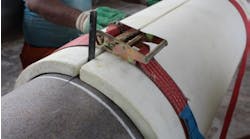Offshore staff
LYSAKER, Norway – Aker BP has issued an update on the impact of bismuth alloy to plug the top section of old oil wells at the Valhall field in the southern Norwegian North Sea.
The technology is now in use for permanent plugging of 30 wells on the field.
The company is making room for new wells to ensure 40 more years of production from Valhall, with a goal of producing 2 Bbbl from the area.
Martin Knut Straume, chief engineer for well plugging, said: “We’ll continue to work on Valhall for many decades to come. That means we have to make sure that we shut down and abandon old wells safely, so that it is safe for us to be there when we continue to produce and drill new wells at the same time.”
Egil Thorstensen, senior engineer P&A, added: “We’re currently installing bismuth plugs in the top section of all the wells…in the 30-in. casing. That’s the last thing we do before we cut and pull the pipes from the seabed to the platform, and the well is permanently abandoned.”
However, plugging wells on Valhall has to be carefully managed due to a combination of gas migration to the surface, subsidence, and compaction. The seabed around the Valhall field center has sunk 7 m (23 ft) since the early 1980s, while the top of the reservoir has dropped about 15 m (49 ft).
Cement, the conventional barrier material for plugging wells, can fail when subjected to wellbore or casing stresses arising from subsidence/ compaction events, with in the worst case, hydrocarbons potentially leaking into the sea.
“Aker BP installed a trial plug over two years ago, and was the first operator worldwide to use bismuth alloy in the top section of the well,” Thorstensen explained.
“When we use this technology, we make sure that the plug is 100% impermeable. Gas cannot leak to the surface.”
Although bismuth alloy is costlier than cement, total costs of plugging the top well sections are said to be lower due to the shorter rig time needed for these operations.
“Bismuth has what cement lacks: it changes almost instantaneously from liquid to solid when the heating source is removed, it is completely impermeable, and it is not affected by contamination issues,” said lead technical engineer Laurent Delabroy.
During the fall of 2020 and winter this year, bismuth plugs were installed continuously from the jackup Maersk Invincible at the field center.
The plugs are up to 2.5 m (8.2 ft) long and weigh 9 metric tons (9.9 tons). The Jack-up rig alliance of Aker BP, Maersk Drilling, and Halliburton managed the campaign, with time spent per well reduced by half to 30 hours this winter.
With months of rig time saved as a result, the rig can now be deployed for new tasks.
05/05/2021



